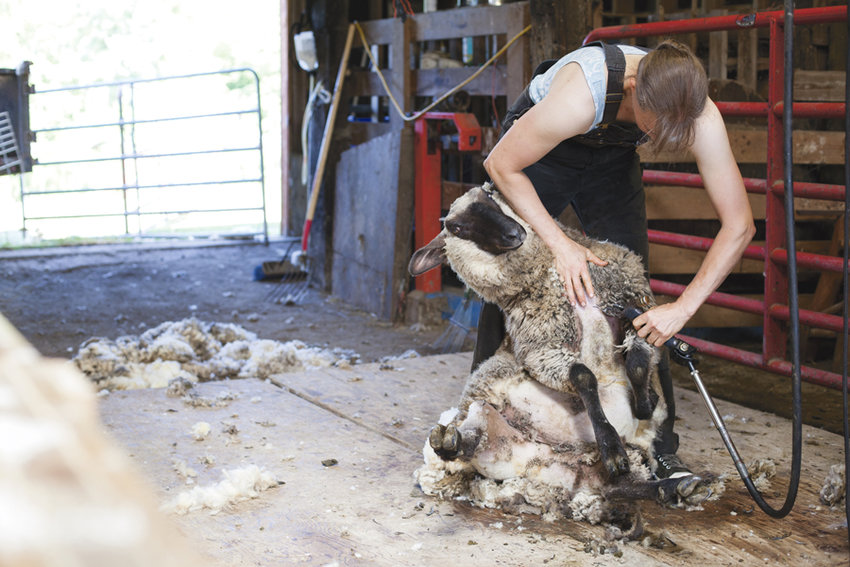 Elizabeth Resager shears one of Kaukiki’s Oxford Down sheep. Photo: Anna Brones
Elizabeth Resager shears one of Kaukiki’s Oxford Down sheep. Photo: Anna Brones
There is an ebb and flow to the year on Kaukiki Farm in Longbranch. There are times when the work slows a bit and when the flow speeds up and there is much to be done.
June increases that flow with sheep shearing at the farm where Janice and Warwick Bryant sustainably raise sheep and cattle.
Sheep shearer Elizabeth Resager deftly wrestles sheep weighing 150 to 300 pounds onto their haunches. She clips their hooves first and then shaves the animal from knee to neck in one long spiral as skillfully as a master chef might peel an apple. Sheep shearers are in short supply and she comes from Bainbridge Island for two days to remove the wool from the Kaukiki flock. She learned the trade 11 years ago when the person who came to shear her own sheep offered to show her how.
June also brings calving. The Bryants keep a small herd of beef cattle along with the sheep. Some yearlings are added to the Kaukiki herd as breed stock and others will be butchered. Some lambs are also butchered on site, some are shipped to Oregon, and others are sold to individuals who want to raise their own animals. Late June and July brings haying, followed by a slower time in August.
Then, near Labor Day, the ewes are pastured with the rams for about a month for breeding. Five months later, in late January or early February, the lambs are born, one or two per ewe, with a subsequent doubling of the flock.
Tending the animals dominates the winter and then, in early April, it is time to tend the pastures. The sheep graze early on, providing a first natural mowing and fertilization. Then Warwick mows the heads of the grass, fertilizes and harrows. And suddenly it is June again and time to shear.
 Warwick Bryant herds sheep to the shearing shed. Photo: Anna Brones
Warwick Bryant herds sheep to the shearing shed. Photo: Anna Brones
The Bryants bought the 140-acre farm in 2007. Janice grew up on a farm in Iowa where she raised rabbits and horses, and Warwick grew up on a sheep station in New Zealand. Kaukiki was the name of the highest hill at the station. They loved the freedom they had as children to explore the world and wanted the same for their sons, Mac, 15, and Jackson, 13.
No matter what the season, days on the farm usually start at 4 in the morning. Sleeping in means rising at 6 on weekends. Janice tends to early-morning chores and then by 5 is on the road to her job as a strategist in an incubator lab for the Navy. With an engineering background and a master’s in public administration, she helps bring ideas from technology—from lasers to robots to nanoparticles—to reality. She picks the boys up at school and is home by 5 p.m. Warwick, who owns Kiwi Fencing, works from home in the early morning before delivering them to school.
The farm is self-sustaining and Kaukiki hay feeds the cattle and sheep with just a little supplement of alfalfa to the ewes shortly before the lambs are born. Warwick also mows hay for much of the Key Peninsula. He fears that some of the skills required for farming are disappearing and that younger generations seem to value freedom above commitment to place. But the near future is clear: The Bryants will continue to farm Kaukiki and don’t plan to leave once they retire from their day jobs.
“This feels like New Zealand.” Warwick said, gesturing to the rolling hills between the barn and main house. “What is cool is that this is where the boys’ friends want to be.”
For more information about Kaukiki Farm, including how to order beef or lamb, go to www. kaukikifarm.com.
UNDERWRITTEN BY THE FUND FOR NONPROFIT NEWS (NEWSMATCH) AT THE MIAMI FOUNDATION, THE ANGEL GUILD, ADVERTISERS, DONORS AND PEOPLE WHO SUPPORT INDEPENDENT, NONPROFIT LOCAL NEWS